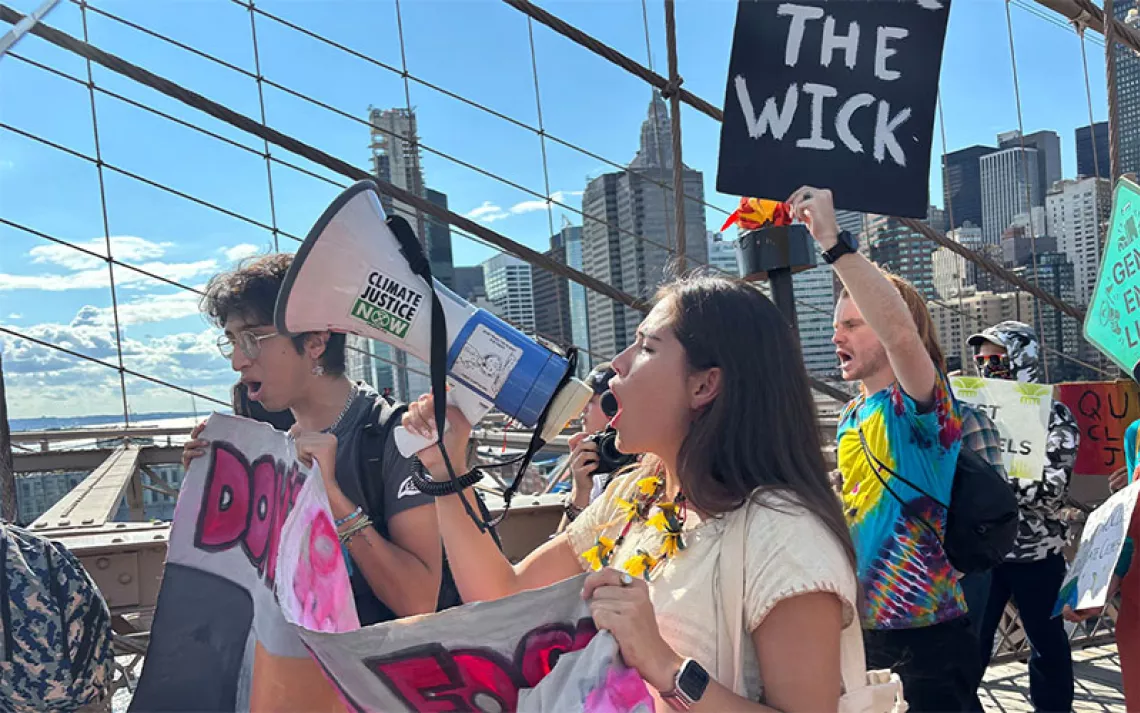Here Comes the National Monument Cleanup Crew
At Grand Staircase–Escalante, locals help others "leave no trace"

Photo by Lee Gelatt
Kaitlin Martin hunched over the bed of her pickup and mulled over a heap of supplies. Our objective on this unblemished desert afternoon was to clean a narrow sandstone slot canyon near the town of Escalante in southern Utah. Martin was trying to decide which implements we'd need to deal with whatever trash and graffiti had been left in the canyon by visitors.
Martin, 27, is the stewardship program manager for the nonprofit Grand Staircase Escalante Partners, whose mission is to help protect and preserve the deep canyons and otherworldly redrock landforms of Grand Staircase–Escalante National Monument. She grabbed an assortment of plastic and wire brushes, spray bottles, and plastic bags. Then she quickly distributed them to the crew, which, in addition to me, included conservation programs manager Kevin Berend, executive director Sarah Bauman, and Bauman's scraggly poodle mix, Luke.
These scrawlings are not innocuous; they're a "gateway drug" that invites more serious forms of vandalism.
"I think we'll go light and leave the shovels," Martin said.
We stuffed the gear inside our packs and set out across a starkly beautiful expanse of desert. As we approached the canyon's brink, Martin spied a pile of toilet paper just below a trail sign. "It's crazy where people will just go," she said as she snapped on a pair of latex gloves. "The view is nice though."
During the past decade, the number of visitors to Utah's national parks and other public lands has ballooned. An aggressive "Mighty 5" marketing campaign run by the Utah Office of Tourism has enticed people from across the country to visit the state's national parks, while Instagram and TikTok have rendered the canyons and monoliths of the Colorado Plateau in irresistible, high-definition glory. Meanwhile, hiking apps like AllTrails and Gaia GPS serve up once obscure and often challenging routes with the touch of a smartphone.
The tourism crush, Martin said, has been accompanied by a spillover into more-remote areas like Grand Staircase–Escalante. In 2021, 1.3 million people visited—more than double the number of visitors the monument saw in 2000. Many of these, she added, were first-timers. "It's great that people are coming, but this is not Arches or Zion," she said. "Grand Staircase is primitive. It's remote and very rugged. It's managed as a wilderness. You can get yourself into a lot of trouble if you don't know what you're doing. And yet a lot of people behave as if they're in a city park."
The core of Martin's job is figuring out how to work with the Bureau of Land Management, which administers the monument, to reduce the impacts from that growing wave of humanity. She is left to carry out that mission with a small budget, most of which is supplied by grants and private donations.
To make the most of limited resources, Martin leads "voluntourism" trips with small groups into some of the monument's most stunning backcountry areas. She and her crew remediate graffiti, dismantle fire rings, and haul hundreds of pounds of trash and human waste out of the canyons every year. As Martin sees it, helping to maintain sensitive landscapes that are on the verge of being loved to death is both karmic and pragmatic. "Plus, you get to do all that hard work while you're out here," she said, sweeping her hand across the redrock panorama. "It beats sitting behind a desk or being in Zoom meetings any day."
True enough. A sandstone ramp soon led us into the canyon, which constricted to no more than four or five feet wide. A soft red light diffused across the walls, which undulated like crimson waves. As our eyes adjusted to the dim light, we noticed drawings scrawled in mud on the sandstone. These were not ancient pictographs but rock art of a much more recent vintage. One wavy line extended for several yards of the canyon—laid down, it appeared, by a finger of a hiker in full stride. On a wall in a sun-splashed alcove, a muddy heart surrounded "J+E."
"Hi" and "Hello" were popular tags. The most common was the simple smiley face, which we encountered everywhere. The faces, though, were no match for a few sprays of our water bottles and scrubs of our plastic brushes, which melted the messages into vague wet splotches.
According to Martin, these scrawlings are not innocuous; they're a "gateway drug" that invites more serious forms of vandalism. She described one section of the canyon that she and a BLM ranger had cleaned a few months earlier. "There were dozens of mud drawings, and around them people were starting to carve patterns and their names into the rock," she said. "It's monkey see, monkey do."
After a quarter mile, the canyon opened into a clearing. Ahead, we spied a woman standing on tiptoe, her hand on the backside of a small child, whom she was helping shimmy up a steep, slick sandstone chute. The chute led to a much narrower slot canyon, 20 feet above. Another group sat on a large rock nearby, waiting for their turn to ascend. On weekends in spring and fall, Bauman said, it's not uncommon for lines dozens of people long to form at the base of this chute.
Our attention quickly turned to a nearby wall, where we encountered a bit of vandalism that required more intensive effort. Someone had carved a spiral and a pattern resembling a pitchfork into a smooth slab. "We'll need the wire brushes for this," Martin said. The patterns were etched deeply—easily a quarter of an inch into the stone—and I wondered aloud if attempting to remove them with our simple tools was futile.
"Do we need a sandblaster?" I asked.
Martin laughed. "Use a light touch with the wire brush," she said. "You'd be surprised how soft sandstone is." Indeed, after a minute or two of delicate scouring, the outline of the pitchfork disappeared with hardly a trace.
Martin said, "If you don't notice that we've been here, we've done our job."
Explore
Take a Sierra Club service trip. For details, go to sc.org/outings.
 The Magazine of The Sierra Club
The Magazine of The Sierra Club



